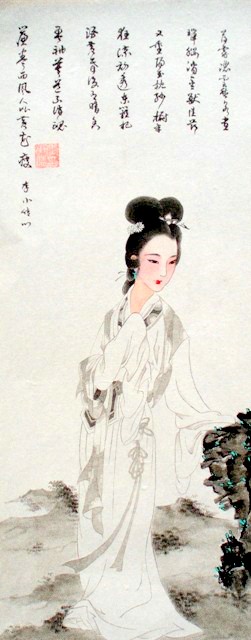 The 白描 technique is similar to 工笔 . Chinese artists say that the art of Bái Miáo is the art of the line. Bái Miáo means "white reproduction," indicating the absence of color in this form of artistic representation of reality. As you might expect, the study of line drawing is highly developed in Bái Miáo painting.
The 白描 technique is similar to 工笔 . Chinese artists say that the art of Bái Miáo is the art of the line. Bái Miáo means "white reproduction," indicating the absence of color in this form of artistic representation of reality. As you might expect, the study of line drawing is highly developed in Bái Miáo painting.
Materials and Supports
Bái Miáo painting is practiced on non-absorbent paper (熟宣 ).
As with the contours in Gōng Bǐ painting, 狼毫 brushes are used. There are mainly four types of Láng Háo brushes:
- The 红毛 (red hair) for thick lines.
- The 衣纹 (clothing folds) for long lines (such as the contours of clothing).
- The 叶筋 (leaf veins) for the contour of flowers and leaves.
- The 蟹爪 (crab claw) for the finest lines (such as dragonfly wings).
However, I strongly recommend using a small 小白规 brush. Master Wang Shuhui, famous for the finesse of his lines, used only a Xiǎo Bái Guī brush to trace all types of contours.
The Different Stages of Bái Miáo Painting
I. Sketching the Outline
Two methods are possible:
The first method involves sketching directly onto the paper you want to paint with a 2B pencil. However, because rice paper is very thin and fragile, you cannot really erase and redraw without damaging the paper. Therefore, you must get it right on the first try. Some minor corrections can be made by lightly erasing.
The second method involves first sketching on a regular drawing sheet (either Western or Chinese, it doesn't matter). This sheet is then placed on the paper you want to paint, with the sketch facing up. You then trace over the outline with a pencil, leaving an impression on the sheet underneath. This sheet will now have lightly imprinted outlines. You can then start painting. If the printed outlines are not visible enough, you can retrace them lightly with a 2B pencil. This method is slower but allows you to avoid damaging the rice paper and also to reuse the sketch for creating a similar painting.
II. Drawing the Contours
The contours are drawn with black ink using the brushes mentioned above. Care must be taken not to make lines of the same thickness. The thick and thin strokes are very important, and it is common to find artists who do not pay enough attention to this.
